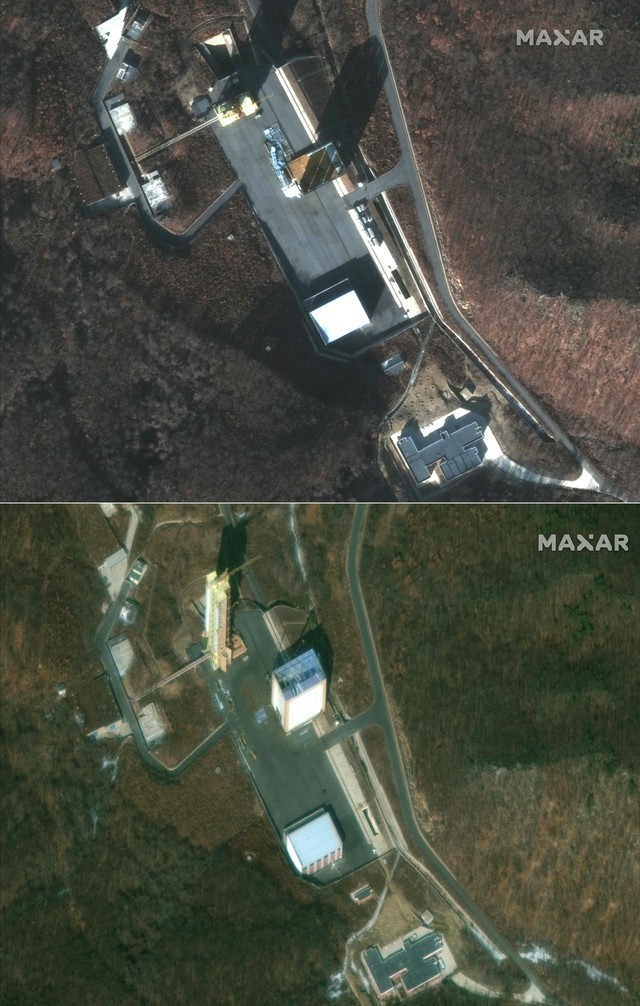NK restoring satellite launch site to gain leverage in negotiations: defense agencies
By Kim So-hyunPublished : April 4, 2019 - 14:46
North Korea’s move to restore a satellite launching site appears to be aimed at using it as leverage in nuclear negotiations, defense authorities said.
Seoul’s Defense Intelligence Agency and the South Korea-US Combined Forces Command said that North Korea was working on rebuilding the Tongchang-ri site even before the second summit between Washington and Pyongyang on Feb. 28, according to Rep. Lee Hye-hoon of the Bareunmirae Party, who leads the National Assembly’s Intelligence Committee.
Seoul’s Defense Intelligence Agency and the South Korea-US Combined Forces Command said that North Korea was working on rebuilding the Tongchang-ri site even before the second summit between Washington and Pyongyang on Feb. 28, according to Rep. Lee Hye-hoon of the Bareunmirae Party, who leads the National Assembly’s Intelligence Committee.

“These agencies said they thought at first that North Korea was planning to invite foreign reporters to the Tongchang-ri site should the summit have positive results,” Lee said in a press briefing Wednesday.
“But the restoration work continued even after the summit fell through, and it looks like it is trying to use it as leverage in negotiations.”
One test of whether the launch site has been restored to an operational level would be the placing of a crane at the launch pad, but the crane has not yet been placed, according to Lee.
The site has only been used for satellite launches in the past, but even these are seen as breaches of sanctions because the technology involved is similar.
The CFC said it cannot rule out the possibility that the North is seeking to resume nuclear development by restoring the site, she said.
“But the restoration work continued even after the summit fell through, and it looks like it is trying to use it as leverage in negotiations.”
One test of whether the launch site has been restored to an operational level would be the placing of a crane at the launch pad, but the crane has not yet been placed, according to Lee.
The site has only been used for satellite launches in the past, but even these are seen as breaches of sanctions because the technology involved is similar.
The CFC said it cannot rule out the possibility that the North is seeking to resume nuclear development by restoring the site, she said.

Last week, the National Intelligence Service said North Korea began restoring the Dongchang-ri site before the Trump-Kim summit in Hanoi, but refused to talk about the communist state’s intentions behind the move.
In Washington, a US commander said at a Senate hearing Wednesday that Kim Jong-un “almost certainly has plans” to use intercontinental ballistic missiles against the US if a conflict erupts on the Korean Peninsula.
Terrence O’Shaughnessy, commander of the North American Aerospace Defense Command and US Northern Command, said, “North Korea’s stockpile of nuclear weapons and ICBMs remain an immediate concern.”
“North Korea’s ICBM program turned the corner in 2017 when it successfully flight-tested multiple ICBMs capable of ranging the continental US and detonated a thermonuclear device, increasing the destructive yield of its weapons by a factor of 10,” O’Shaughnessy said during the hearing on missile defense held by a subcommittee on strategic forces under the US Senate Committee on Armed Services.
“Following the successes, Kim Jong-un declared the completion of his nuclear ICBM research and development program, implying the production and deployment of these systems would soon follow.”
Others at the hearing also warned that North Korea remains capable of further testing of strategic weapons.
Samuel Greaves, director of the US Missile Defense Agency, mentioned North Korea’s two tests of a solid-propellant medium-range ballistic missile capable of reaching Japan, which were not done from Tongchang-ri.
“This advancement is significant because solid-propellant missiles can be prepared for launch more rapidly than liquid-propellant systems, which challenges US pre-launch counter missile operations,” he said.
US Undersecretary of Defense for Policy John Rood said during the hearing, “While North Korea has not tested nuclear-capable missiles in over a year, it possesses a range of systems, including road-mobile intercontinental-range ballistic missiles, solid-propellant medium-range ballistic missiles and submarine-launched ballistic missiles.”
(sophie@heraldcorp.com)
In Washington, a US commander said at a Senate hearing Wednesday that Kim Jong-un “almost certainly has plans” to use intercontinental ballistic missiles against the US if a conflict erupts on the Korean Peninsula.
Terrence O’Shaughnessy, commander of the North American Aerospace Defense Command and US Northern Command, said, “North Korea’s stockpile of nuclear weapons and ICBMs remain an immediate concern.”
“North Korea’s ICBM program turned the corner in 2017 when it successfully flight-tested multiple ICBMs capable of ranging the continental US and detonated a thermonuclear device, increasing the destructive yield of its weapons by a factor of 10,” O’Shaughnessy said during the hearing on missile defense held by a subcommittee on strategic forces under the US Senate Committee on Armed Services.
“Following the successes, Kim Jong-un declared the completion of his nuclear ICBM research and development program, implying the production and deployment of these systems would soon follow.”
Others at the hearing also warned that North Korea remains capable of further testing of strategic weapons.
Samuel Greaves, director of the US Missile Defense Agency, mentioned North Korea’s two tests of a solid-propellant medium-range ballistic missile capable of reaching Japan, which were not done from Tongchang-ri.
“This advancement is significant because solid-propellant missiles can be prepared for launch more rapidly than liquid-propellant systems, which challenges US pre-launch counter missile operations,” he said.
US Undersecretary of Defense for Policy John Rood said during the hearing, “While North Korea has not tested nuclear-capable missiles in over a year, it possesses a range of systems, including road-mobile intercontinental-range ballistic missiles, solid-propellant medium-range ballistic missiles and submarine-launched ballistic missiles.”
(sophie@heraldcorp.com)










![[Hello India] Hyundai Motor vows to boost 'clean mobility' in India](http://res.heraldm.com/phpwas/restmb_idxmake.php?idx=644&simg=/content/image/2024/04/25/20240425050672_0.jpg&u=)









